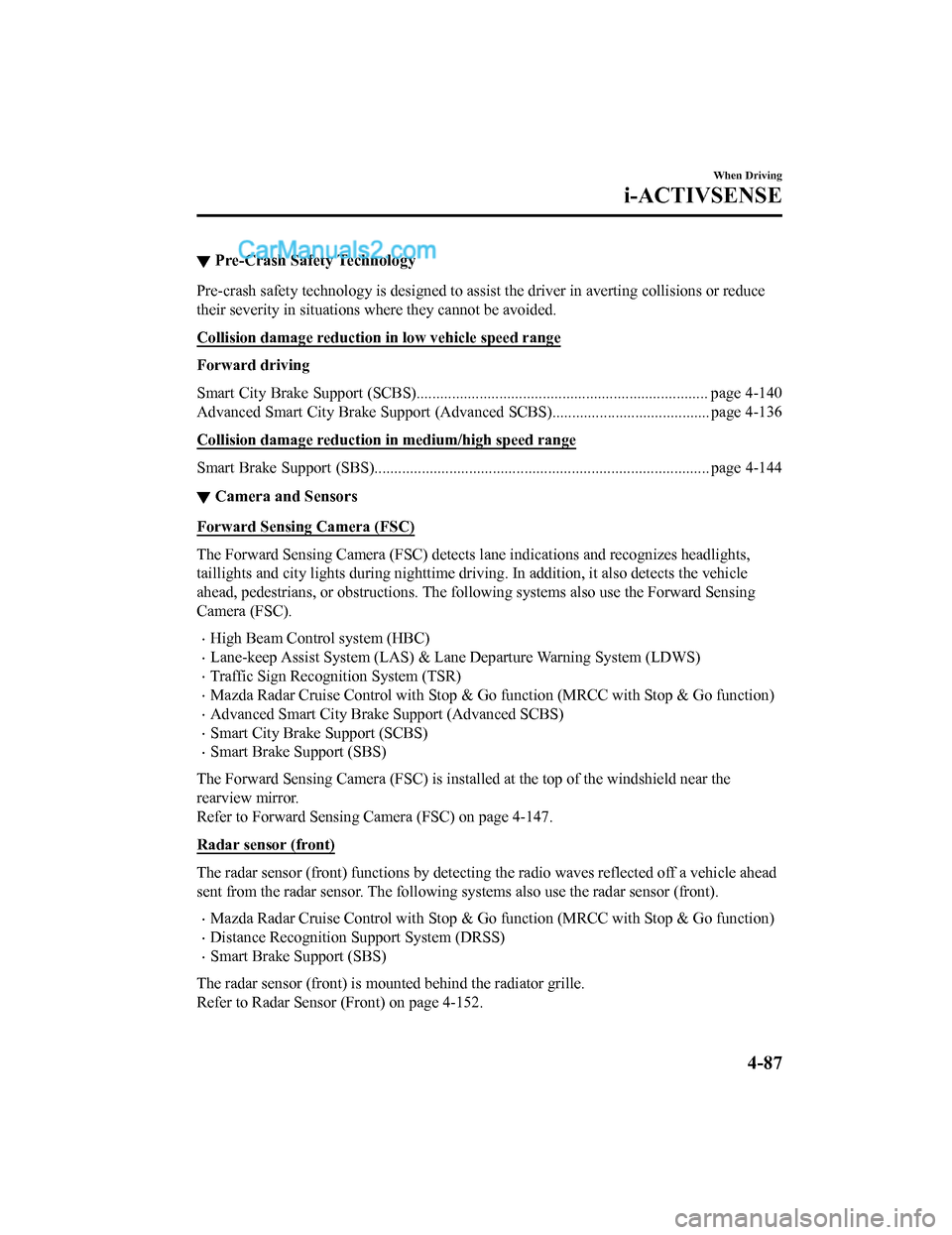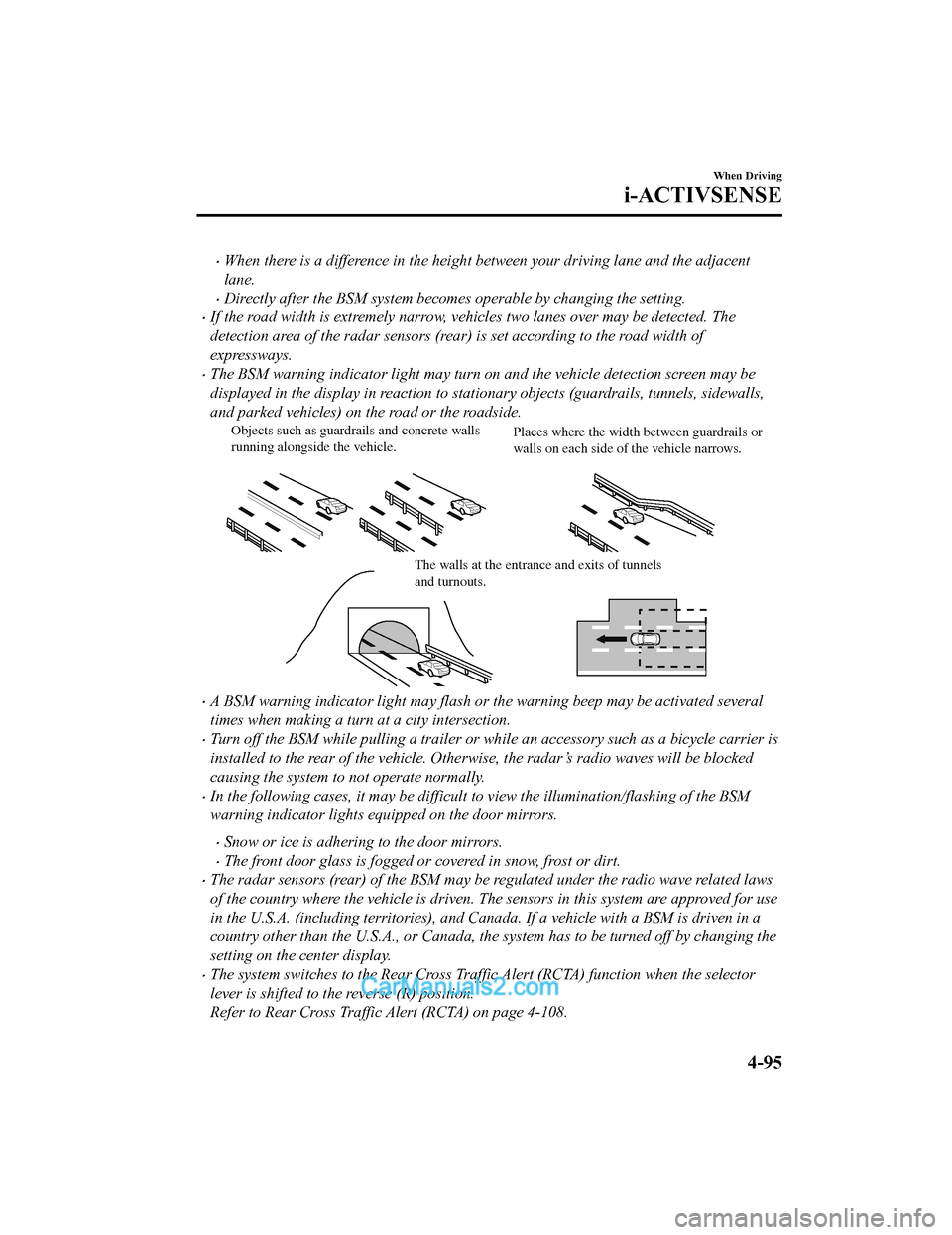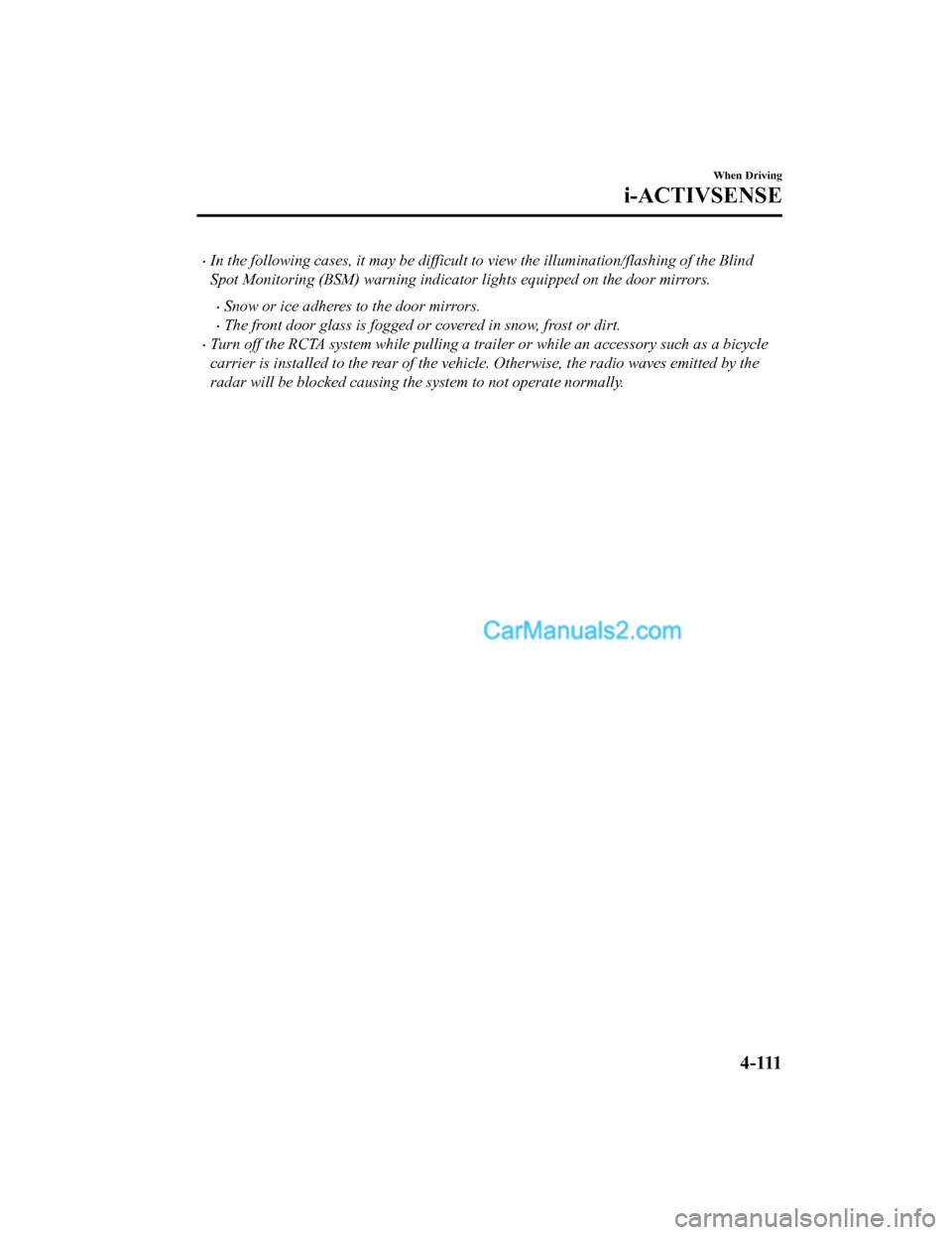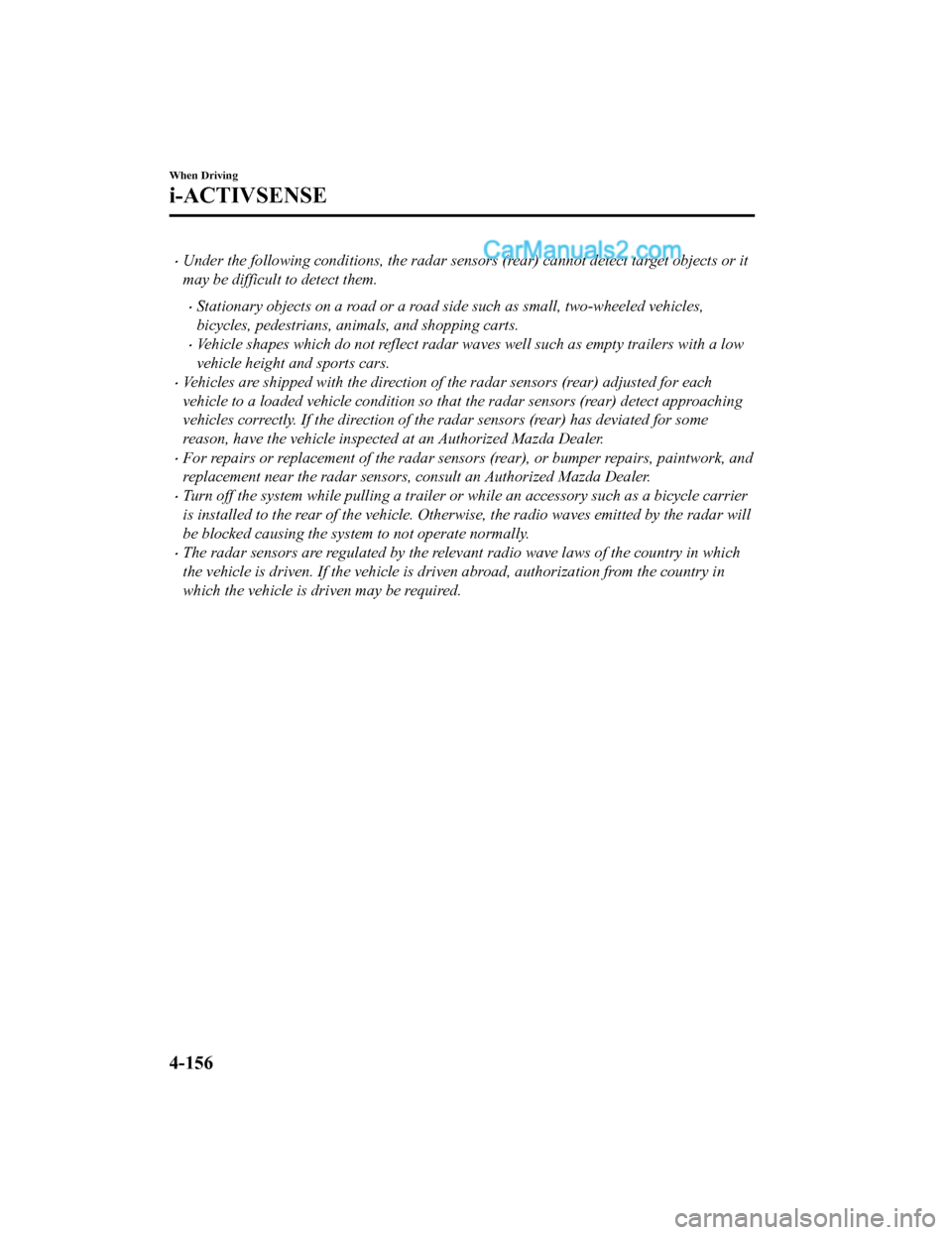radio MAZDA MODEL CX-5 2018 (in English) User Guide
[x] Cancel search | Manufacturer: MAZDA, Model Year: 2018, Model line: MODEL CX-5, Model: MAZDA MODEL CX-5 2018Pages: 628, PDF Size: 82.38 MB
Page 223 of 628

▼Pre-Crash Safety Technology
Pre-crash safety technology is de
signed to assist the driver in averting collisions or reduce
their severity in situations where they cannot be avoided.
Collision damage reduction in low vehicle speed range
Forward driving
Smart City Brake Support (SCBS)................................ .......................................... page 4-140
Advanced Smart City Brake Support (Advanced SCBS).............. .......................... page 4-136
Collision damage reduction in medium/high speed range
Smart Brake Support (SBS)...................................... ............................................... page 4-144
▼Camera and Sensors
Forward Sensing Camera (FSC)
The Forward Sensing Camera (FSC) detects lane indications and recognizes headlights,
taillights and city lights during
nighttime driving. In addition, it also detects the vehicle
ahead, pedestrians, or obstructi ons. The following systems also use the Forward Sensing
Camera (FSC).
•High Beam Control system (HBC)
•Lane-keep Assist System (LAS) & Lane Departure Warning System ( LDWS)
•Traffic Sign Recognition System (TSR)
•Mazda Radar Cruise Control with Stop & Go function (MRCC with S top & Go function)
•Advanced Smart City Brake Support (Advanced SCBS)
•Smart City Brake Support (SCBS)
•Smart Brake Support (SBS)
The Forward Sensing Camera (FSC) is installed at the top of the windshield near the
rearview mirror.
Refer to Forward Sensing Camera (FSC) on page 4-147.
Radar sensor (front)
The radar sensor (front) functions by detecting the radio waves reflected off a vehicle ahead
sent from the radar sensor. The following systems also use the radar sensor (front).
•Mazda Radar Cruise Control with Stop & Go function (MRCC with S top & Go function)
•Distance Recognition Support System (DRSS)
•Smart Brake Support (SBS)
The radar sensor (front) is mount ed behind the radiator grille.
Refer to Radar Sensor (Front) on page 4-152.
When Driving
i-ACTIVSENSE
4-87
CX-5_8GN5-EA-17J_Edition1 2017-8-18 12:58:27
Page 224 of 628

Radar sensors (rear)
The radar sensors (rear) function by detecting the radio waves reflected off a vehicle
approaching from the rear or an obstruction sent from the radar sensors. The following
systems also use the radar sensors (rear).
•Blind Spot Monitoring (BSM)
•Rear Cross Traffic Alert (RCTA)
The radar sensors (rear) are inst alled inside the rear bumper, one each on the left and right
sides.
Refer to Radar S ensors (Rear) on page 4-155.
When Driving
i-ACTIVSENSE
4-88
CX-5_8GN5-EA-17J_Edition1 2017-8-18 12:58:27
Page 231 of 628

•When there is a difference in the height between your driving lane and the adjacent
lane.
•Directly after the BSM system becomes operable by changing the setting.
•If the road width is extremely narrow, vehicles two lanes over may be detected. The
detection area of the radar sensors (rear) is set according to the road width of
expressways.
•The BSM warning indicator light may turn on and the vehicle detection screen may be
displayed in the display in reaction to stationary objects (guardrails, tunnels, sidewalls,
and parked vehicles) on the road or the roadside.
Objects such as guardrails and concrete walls
running alongside the vehicle. Places where the width between guardrails or
walls on each side of the vehicle narrows.
The walls at the entrance and exits of tunnels
and turnouts.
•A BSM warning indicator light may flash or the warning beep may be activated several
times when making a turn at a city intersection.
•Turn off the BSM while pulling a trailer or wh
ile an accessory such as a bicycle carrier is
installed to the rear of the vehicle. Otherwise, the radar’s radio waves will be blocked
causing the system to not operate normally.
•In the following cases, it may be difficult to view the illumination/flashing of the BSM
warning indicator lights equipped on the door mirrors.
•Snow or ice is adhering to the door mirrors.
•The front door glass is fogged or covered in snow, frost or dirt.
•The radar sensors (rear) of the BSM may be regulated under the radio wave related laws
of the country where the vehicle is driven. The sensors in this system are approved for use
in the U.S.A. (including territories), and Canada. If a vehicle with a BSM is driven in a
country other than the U.S.A., or Canada, the system has to be turned off by changing the
setting on the center display.
•The system switches to the Rear Cross Traffic Alert (RCTA) function when the selector
lever is shifted to the reverse (R) position.
Refer to Rear Cross Traffic Alert (RCTA) on page 4-108.
When Driving
i-ACTIVSENSE
4-95
CX-5_8GN5-EA-17J_Edition1 2017-8-18 12:58:27
Page 246 of 628

•A large deviation in the installation position of a radar sensor (rear) on the vehicle has
occurred.
•There is a large accumulation of snow or ice on the rear bumper near a radar sensor
(rear).
•Driving on snow-covered roads for long periods.
•The temperature near the radar sensors becomes extremely hot due to driving for long
periods on slopes during the summer.
•The battery voltage has decreased.
•Under the following conditions, the radar sensors (rear) cannot detect target objects or it
may be difficult to detect them.
•The vehicle speed when reversing is about 15 km/h (9 mph) or faster.
•The radar sensor (rear) detection area is obstructed by a nearby wall or parked vehicle.
(Reverse the vehicle to a position where the radar sensor detection area is no longer
obstructed.)
Your vehicle
•A vehicle is approaching directly from the rear of your vehicle.
Your vehicle
•The vehicle is parked on a slant.
Your vehicle
•Directly after the Blind Spot Monitoring (BSM) system becomes operable using the
personalization feature.
•Radio wave interference from a radar sensor equipped on a nearby parked vehicle.
When Driving
i-ACTIVSENSE
4-110
CX-5_8GN5-EA-17J_Edition1 2017-8-18 12:58:27
Page 247 of 628

•In the following cases, it may be difficult to view the illumination/flashing of the Blind
Spot Monitoring (BSM) warning indicator lights equipped on the door mirrors.
•Snow or ice adheres to the door mirrors.
•The front door glass is fogged or covered in snow, frost or dirt.
•Turn off the RCTA system while pulling a trailer or while an accessory such as a bicycle
carrier is installed to the rear of the vehic le. Otherwise, the radio waves emitted by the
radar will be blocked causing the system to not operate normally.
When Driving
i-ACTIVSENSE
4 - 111
CX-5_8GN5-EA-17J_Edition1 2017-8-18 12:58:27
Page 288 of 628

Radar Sensor (Front)*
Your vehicle is equipped with a radar sensor (front).
The following systems also use the radar sensor (front).
•Distance Recognition Support System (DRSS)
•Mazda Radar Cruise Control with S top & Go function (MRCC with Stop & Go function)
•Smart Brake Support (SBS)
The radar sensor (front) function s by detecting the radio waves reflected off a vehicle ahead
or an obstruction sent from the radar sensor.
The radar sensor (front) is m ounted behind the front emblem.
Radar sensor (front)
If “Front Radar Sensor Blocked” is displayed in the multi-infor mation display of the
instrument cluster, clean the area around the radar sensor (fro nt).
CAUTION
Heed the following precautions to assure correct operation of each system.
Do not adhere stickers (including transparent stickers) to the surface of the radiator grille
and front emblem in and around the radar sensor (front), and do not replace the radiator
grille and front emblem with any product that is not a genuine product designed for use
with the radar sensor (front).
The radar sensor (front) includes a function for detecting soiling of the radar sensor's front
surface and informing the driver, however, depending on the conditions, it may require
time to detect or it may not detect plastic shopping bags, ice or snow. If this occurs, the
system may not operate correctly, therefore al ways keep the radar sensor (front) clean.
Do not install a grille guard.
If the front part of the vehicle has been dama ged in a vehicle accident, the position of the
radar sensor (front) may have moved. Stop the system immediately and always have the
vehicle inspected at an Authorized Mazda Dealer.
When Driving
i-ACTIVSENSE
4-152*Some models.
CX-5_8GN5-EA-17J_Edition1 2017-8-18 12:58:27
Page 289 of 628

Do not use the front bumper to push other vehicles or obstructions such as when pulling
out of a parking space. Otherwise, the radar sensor (front) could be hit and its position
deviated.
Do not remove, disassemble, or mo dify the radar sensor (front).
For repairs, replacement or paint work ar ound the radar sensor (front), consult an
Authorized Mazda Dealer.
Do not modify the suspension. If the suspensi on are modified, the vehicle's posture could
change and the radar sensor (front) may not be able to correctly detect a vehicle ahead or
an obstruction.
NOTE
•Under the following conditions, the radar sensor (front) may not be able to detect vehicles
ahead or obstructions correctly and each system may not operate normally.
•The rear surface of a vehicle ahead does not reflect radio waves effectively, such as an
unloaded trailer or an automobile with a loading platform covered by a soft top,
vehicles with a hard plastic tailgate, and round-shaped vehicles.
•Vehicles ahead with low vehicle height and thus less area for reflecting radio waves.
•Visibility is reduced due to a vehicle ahead casting off water, snow, or sand from its tires
and onto your windshield.
•The luggage compartment is loaded with heavy objects or the rear passenger seats are
occupied.
•Ice, snow, or soiling is on the front surface of the front emblem.
•During inclement weather such as rain, snow, or sand storms.
•When driving near facilities or objects emitting strong radio waves.
•Under the following conditions, the radar sensor (front) may not be able to detect vehicles
ahead or obstructions.
•The beginning and end of a curve.
•Roads with continuous curves.
•Narrow lane roads due to road construction or lane closures.
•The vehicle ahead enters the radar sensor's blind spot.
•The vehicle ahead is running abnormally due to accident or vehicle damage.
•Roads with repeated up and down slopes
•Driving on poor roads or unpaved roads.
•The distance between your vehicle and the vehicle ahead is extremely short.
•A vehicle suddenly comes close such as by cutting into the lane.
•To prevent incorrect operation of the system, use tires of the same specified size,
manufacturer, brand, and tread pattern on all four wheels. In addition, do not use tires
with significantly different wear patterns or tire pressures on the same vehicle (Including
the temporary spare tire).
•If the battery power is weak, the system may not operate correctly.
When Driving
i-ACTIVSENSE
4-153
CX-5_8GN5-EA-17J_Edition1 2017-8-18 12:58:27
Page 291 of 628

Radar Sensors (Rear)*
Your vehicle is equipped with radar sensors (rear). The following systems also use the radar
sensors (rear).
•Blind Spot Monitoring system (BSM)
•Rear Cross Traffic Alert (RCTA)
The radar sensors (rear) function by detecting the radio waves reflected off a vehicle
approaching from the rear or an obstruction sent from the radar sensor.
Radar sensors (rear)
The radar sensors (rear) are installed inside the rear bumper, one each on the left and right
sides.
Always keep the surface of the rear bumper near the radar senso rs (rear) clean so that the
radar sensors (rear) operate normally. Also, do not apply items such as stickers.
Refer to Exterior Care on page 6-48.
CAUTION
If the rear bumper receives a severe impact, the system may no longer operate normally. Stop
the system immediately and have the vehicle inspected at an Authorized Mazda Dealer.
NOTE
•The detection ability of the radar sensors (rear) has limitations. In the following cases,
the detection ability may lower and the system may not operate normally.
•The rear bumper near the radar sensors (rear) has become deformed.
•Snow, ice or mud adheres to the radar sensors (rear) on the rear bumper.
•Under bad weather conditions such as rain, snow and fog.
When Driving
i-ACTIVSENSE
*Some models.4-155
CX-5_8GN5-EA-17J_Edition1 2017-8-18 12:58:27
Page 292 of 628

•Under the following conditions, the radar sensors (rear) cannot detect target objects or it
may be difficult to detect them.
•Stationary objects on a road or a road side such as small, two-wheeled vehicles,
bicycles, pedestrians, animals, and shopping carts.
•Vehicle shapes which do not reflect radar waves well such as empty trailers with a low
vehicle height and sports cars.
•Vehicles are shipped with the direction of the radar sensors (rear) adjusted for each
vehicle to a loaded vehicle condition so that the radar sensors (rear) detect approaching
vehicles correctly. If the direction of the radar sensors (rear) has deviated for some
reason, have the vehicle inspected at an Authorized Mazda Dealer.
•For repairs or replacement of the radar sensors (rear), or bumper repairs, paintwork, and
replacement near the radar sensors, consult an Authorized Mazda Dealer.
•Turn off the system while pulling a trailer or while an accessory such as a bicycle carrier
is installed to the rear of the vehicle. Otherwise, the radio waves emitted by the radar will
be blocked causing the system to not operate normally.
•The radar sensors are regulated by the relevant radio wave laws of the country in which
the vehicle is driven. If the vehicle is driven abroad, authorization from the country in
which the vehicle is driven may be required.
When Driving
i-ACTIVSENSE
4-156
CX-5_8GN5-EA-17J_Edition1 2017-8-18 12:58:27
Page 298 of 628

Tire Pressure Monitoring System
The Tire Pressure Monitoring System (TPMS) monitors the pressure for each tire.
If tire pressure is to o low in one or more tires, the system will inform the driver via the
warning light in the instrument cluster and by the warning beep sound.
Refer to Warning Indication/Warning Lights on page 4-30.
Refer to Tire Inflation Pressu re Warning Beep on page 7-45.
The tire pressure sensors installed on each wheel send tire pre ssure data by radio signal to
the receiver unit in the vehicle.
Tire pressure sensors
NOTE
When the ambient temperature is low due to seasonal changes, tire temperatures are also
lower. When the tire temperature decreases, the air pressure decreases as well. The TPMS
warning light may illumina te more frequently. Visually inspect the tires daily before driving,
and check tire pressures monthly with a tire pressure gauge. When checking tire pressures,
use of a digital tire pressure gauge is recommended.
TPMS does not alleviate your need to check the pressure and con dition of all four tires
regularly.
When Driving
Tire Pressure Monitoring System
4-162
CX-5_8GN5-EA-17J_Edition1 2017-8-18 12:58:27